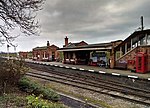Woodthorpe, Leicestershire
Borough of CharnwoodFormer civil parishes in LeicestershireHamlets in LeicestershireLeicestershire geography stubsUse British English from July 2015

Woodthorpe is a hamlet just south of Loughborough and former civil parish in the Charnwood district, in Leicestershire, England. In 1931 the parish had a population of 53.In the Imperial Gazetteer of England and Wales (1870–72) John Marius Wilson described Woodthorpe: WOODTHORPE, a hamlet in Loughborough parish, Leicester; 1½ mile S of Loughborough. Real property, £1,236. Pop., 67. Houses, 16. Woodthorpe became a parish in 1866, on 1 April 1935 the parish was abolished and merged with Loughborough, part also went to Quorndon and Woodhouse.
Excerpt from the Wikipedia article Woodthorpe, Leicestershire (License: CC BY-SA 3.0, Authors, Images).Woodthorpe, Leicestershire
Main Street, Charnwood
Geographical coordinates (GPS) Address Nearby Places Show on map
Geographical coordinates (GPS)
| Latitude | Longitude |
|---|---|
| N 52.751111111111 ° | E -1.1965277777778 ° |
Address
Main Street 66
LE12 8UG Charnwood
England, United Kingdom
Open on Google Maps






